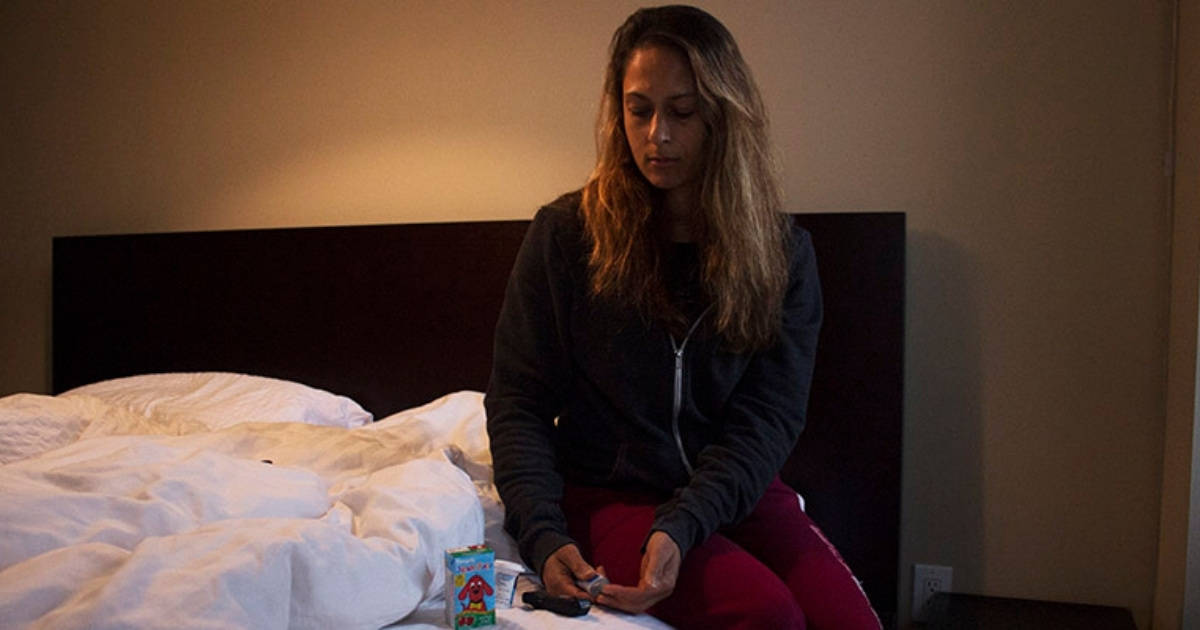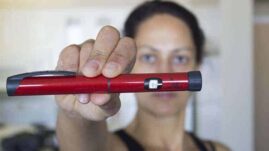Target blood sugar ranges can vary not only throughout your lifetime, but throughout a typical day as well!
You may opt to have a higher blood sugar before exercise, for example, or a lower blood sugar before eating dessert. This all depends on the individual.
But one common question is what should your blood sugar be at bedtime?
This article will discuss the importance of having a safe blood sugar before bed, what to do to achieve it, and other tips for better blood sugar management in the evening.

What are normal blood sugar levels?
While this range is different for everyone, typically, someone with diabetes will aim for blood sugar levels to be between 70-130 mg/dL throughout the day, before meals.
The American Diabetes Association recommends a blood sugar no higher than 180 mg/dL two hours after a meal. Work with your doctor to find out what ideal range will work for you and your health goals.
For instance, for someone who is pregnant, blood sugar management needs to be tighter, with fasting blood sugars staying between 70-100 mg/dL and a blood sugar no higher than 140 mg/dL after meals.
For someone who struggles with hypo unawareness, where they cannot detect or feel their own low blood sugar levels, a goal blood sugar range may be slightly higher, to avoid dangerous and spiraling low blood sugar levels.
Goal blood sugar levels before bedtime, however, tend to be slightly different than those during the day.
Why are bedtime blood sugar goals different?
Many people struggle with their blood sugar levels overnight. This is because we’re not awake for a stretch of between 8 and 10 hours to course correct in the form of taking extra insulin or eating carbohydrates to avoid both high and low blood sugars!
It can be difficult to eat an evening meal and then expect perfect blood sugar levels all night long. And while overnight high blood sugars are annoying and can make us feel sick (and over the long term, even contribute to diabetes complications), it’s low blood sugar levels overnight that are acutely dangerous and need to be avoided as much as possible.
This is especially true if you struggle with hypo unawareness, or if you don’t have a continuous glucose monitor (CGM) that can help detect low blood sugar levels for you, and alarm you if it needs to be treated with fast-acting glucose.
What are recommended blood sugar levels at bedtime?
While during the day your goal blood sugar range may be lower, it’s generally recommended to not go to bed with a blood sugar level under 100 mg/dL, especially if you have active insulin on board (insulin that is still active in your bloodstream and thus more likely to make you go low).
You will need to treat most blood sugars under 100 mg/dL with a snack to make sure your blood sugar levels are stabilized for sleep.
This can help prevent dangerous low blood sugar levels overnight, especially if you’re on multiple daily injections (MDI) and/or do not have a continuous glucose monitor (CGM).
On the other hand, you do not want to go to sleep with too high of a blood sugar level, as this can lead to dangerous hyperglycemia while you sleep, setting you up for long-lasting high blood sugars the next morning.
Work with your doctor to see what will work best for you, but typically any blood sugar over 180 mg/dL before bedtime needs to be corrected with an insulin bolus.
Tips for stabilizing blood sugar levels at bedtime
This video and the following tips can help you stabilize your blood sugar levels around bedtime, so you don’t go too high or too low overnight.
Preventing low blood sugar overnight
- Have a snack before bed that is full of both fat and protein, as this will slow digestion of the carbohydrates, and stabilize glucose levels
- If you regularly exercise, do so earlier in the day
- Have a lower carbohydrate dinner, so you have less insulin on board before going to sleep
- Limit alcohol in general, and especially right before bed, as this can make blood sugar levels crash
- Lower your insulin basal rates overnight if you use an insulin pump
- if you’re on multiple daily injections (MDI), take your long-acting dose in the morning, so it’s not as strong overnight (or split it between mornings and evenings). Work with your doctor before adjusting any insulin dose or timing of doses.
- Get a continuous glucose monitor (CGM) and set your low alarm higher than what you would treat a low blood sugar level at, so you can wake up and adjust before experiencing a dangerous low blood sugar.
Preventing high blood sugar overnight
- Eat a lower-carbohydrate dinner, so you have fewer active carbohydrates in your system before bed.
- Eat dinner earlier in the evening, and don’t snack for 1-2 hours before going to bed
- Increase the amount of protein and fat in your dinner
- Take a 10-20 minute walk after dinner to help prevent postprandial glucose excursions
- Take a hot shower before bed; the heat helps stimulate insulin in your blood vessels and can help lower blood sugar levels
- Increase your overnight basal rates, or if you’re MDI, split your long-acting dose, taking half in the morning and half before bedtime, so you’ll have extra insulin on board to fight those overnight highs
- Get a CGM and set a high alarm, so you’re alerted when your blood sugar is spiking in your sleep, and you can bolus and course-correct overnight as needed
Conclusions
Managing blood sugar levels overnight can be the hardest part of diabetes, simply because we’re asleep! But good blood sugar management overnight all starts with a good blood sugar level at bedtime.
Goal blood sugar ranges will vary from person to person, but typically, it’s best to not have a blood sugar level under 100 mg/dL before bedtime and nothing over 180 mg/dL either.
Some strategies can help prevent low blood sugars overnight, including lowering your basal rates or changing the timing of your insulin, eating a high-protein, high-fat snack before bed, and not exercising in the evening.
A few strategies to help prevent high blood sugar levels overnight include, eating fewer carbohydrates at dinnertime, eating dinner earlier in the evening, going for a short walk after dinner, taking a hot shower, and increasing your basal rates and/or changing around the timing of your insulin doses.
In both cases, having a CGM to help alert you to high and low blood sugar levels before they become dangerous is crucial for a more peaceful (and safer!) night’s sleep.
Work with your doctor to figure out what your ideal blood sugar should be before bedtime, and what tactics would be most appropriate to help you prevent both high and low blood sugars while you sleep.
For more tips on managing your blood sugar at night, you can read our guide: How to Avoid High Blood Sugar at Night




Linda Somekh
Hi – first of all I want to say that I love your newsletter and find it better than any magazine I read and I do read a lot to stay informed! I have the Medtronic 780 with its CGM sensor and it’s a life saver – if my sugar goes high or low at night it automatically corrects it so I always wake up in range. From what I know Dexcom does not have a CGM that works with the CGM – correct?
Christel Oerum, MS
The Dexcom CGM does not work with the Medtronic pump, only the Medtronic CGMs do.
Helen Fitz Anderson
My blood sugar tested 5.4 before going to bed and 6.9 when I woke up at 10 am. Why is that
Christel Oerum, MS
Your body needs energy 24/7, so even if you haven’t eaten for many hours your body will supply you with glucose stored in muscles and liver.
Many will see a larger increase in glucose in the morning due to the Dawn phenomenon (you can read more here https://diabetesstrong.com/the-dawn-phenomenon-what-it-is-and-how-to-manage-it/)
Tim
My diabetes team is rather adamant about not taking any bolus at night out of fear we go low. But I insist I take a few units if I am over 200.
I usually ŵake up around 5-6 am somewhere around 120 to 140.
Pramod
Very informative and helpful article.
Early dinner is also the key, so one’ can correct, after 2 hours with a protein snack. Excellent, keep sending
Andrea
Hi, I take novolin n before bedtime. I have a snack at 9 pm of 1 piece of whole wheat toast with 1/3 cup of 1% cottage cheese and a tablespoon of either walnuts almonds roasted peanuts or seeds. I take 5 units of the nph. I checked my blood sugar at 2 am it was 101 checked again at 4 am it was 98 and 80 fasting when woke up. Last night I did the same my blood sugar was 114 at 3:30 am and 148 when I woke up. I can’t figure out what to do anymore. I am 65 years old. I had it since I was 7 years old. It is totally stressing me. I just can’t stabilize it when sleeping. Can you help me.
Christel Oerum
You can have days where your blood sugar fluctuates differently than other days, that’s normal. Many things outside what you eat and the insulin you take can impact blood sugars, so aiming for exactly the same outcome daily is probably not realistic. However, if you start seeing patterns of, for example, waking up with elevated blood sugars daily, then you might need to discuss changing your treatment plan with your doctor. When it comes to diabetes I don’t think we can strive for perfection but rather for doing the best that we can
joyce f stamps
Hi my doc has recently put me on rybelsus. Do i need to eat more food while on this medicine?.I like to eat two meals a day that is breakfast and dinner,I am currently pre-diabetic.
Christel Oerum
Unless your doctor has recommended that you change your eating habits or if you’re seeing side effects from taking the medication there is probably no need to change your eating habits.
Dave
Hmmm. Hi protein and hi fat. I came up with 1. whole milk, 2. a protein bar, 3. a dish of ice cream. Do you have other suggestions?